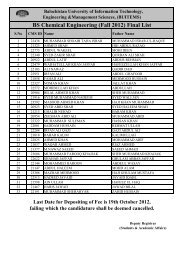BUITEMS
Research Journal - buitems
Research Journal - buitems
- No tags were found...
You also want an ePaper? Increase the reach of your titles
YUMPU automatically turns print PDFs into web optimized ePapers that Google loves.
<strong>BUITEMS</strong><br />
Quality & Excellence in Education<br />
Flow Dynamics of Two Phase (air and water ) Stratified Flow by a Simulation Package COMSOL MULTIPHYSICS<br />
The figure showing different boundaries is<br />
given in Appendix A.<br />
Results without Surface Tension and<br />
Gravity<br />
The figure below is the result of flow of air<br />
over water at rest but provided an outlet.<br />
Basically in this flow problem the water is<br />
shear driven, shear forces act at the interface<br />
of flowing air and still water.<br />
With no gravity and surface tension<br />
coefficient, it is observed that when air flows<br />
over water, the water level falls at start of the<br />
water section. The fall in water section goes<br />
approximately to the water wall contact,<br />
forming slug, but the water level at the exit<br />
of the water section remains constant. It was<br />
expected since the cause of this pattern is<br />
the absence of gravity, as in the absence of<br />
gravity no external force acts on the flow and<br />
the water level does not falls at the exit. At<br />
the entrance when air just contacts the water<br />
surface, the fall of water is due to drag, as<br />
there is no inflow of water and, water flows<br />
to the exit by interfacial shear force.<br />
The pressure distribution is quite different<br />
here (Appendix A). The pressure decreases<br />
with the flow from left to the right in three<br />
stages, in the beginning, in the middle and in<br />
the end of flow. All pressure reductions takes<br />
place suddenly. It means, no hydrostatic<br />
pressure acts here.<br />
Initially in the water section, water is at rest<br />
with no inflow. When the flowing air with<br />
velocity interacts with water, the direction of<br />
the velocity changes to the down side due to<br />
the water displacement and creation of wave.<br />
Air moves the water with a little velocity. The<br />
air gets maximum velocity at the top of the<br />
wave due to pressure reduction by wave<br />
generation.<br />
Figure 5. Result of the flow when Gravity and<br />
Surface tension are not considered.<br />
Results with a Little Gravity and Surface<br />
Tension<br />
Here again it was tried to check the effect of<br />
gravity(which must be taken into account) by<br />
introducing a little value of Gravity 2m/s2 and<br />
also by introducing Surface tension<br />
coefficient. Here the result is a bit satisfactory<br />
as the water level at the exit falls down mainly<br />
due to gravity and somewhat due to shear.<br />
As the water is shear driven, and is under<br />
effect of gravity, the water level falls abruptly<br />
at the exit and slowly at the start. If this goes<br />
on, the water will be drained out of the section.<br />
By introducing the gravity, the pressure<br />
distribution is quite natural here, higher at the<br />
bottom due to hydrostatic pressure of water<br />
and lower at the top wall (air-wall contact).<br />
(See appendix A) As the water falls down due<br />
to gravity, a decrease in pressure takes place<br />
above in the air zone and back flow of the air<br />
occurs. The result just by introducing a value<br />
of small gravity but keeping the surface<br />
tension zero, the flow pattern is as when both<br />
quantities were introduced.<br />
When, only Surface tension coefficient was<br />
introduced as in the first model, no effects<br />
were observed. It just behaves as it does<br />
without Surface tension coefficient.<br />
Figure 6. The result when Gravity and Surface<br />
tension are introduced.<br />
92
















